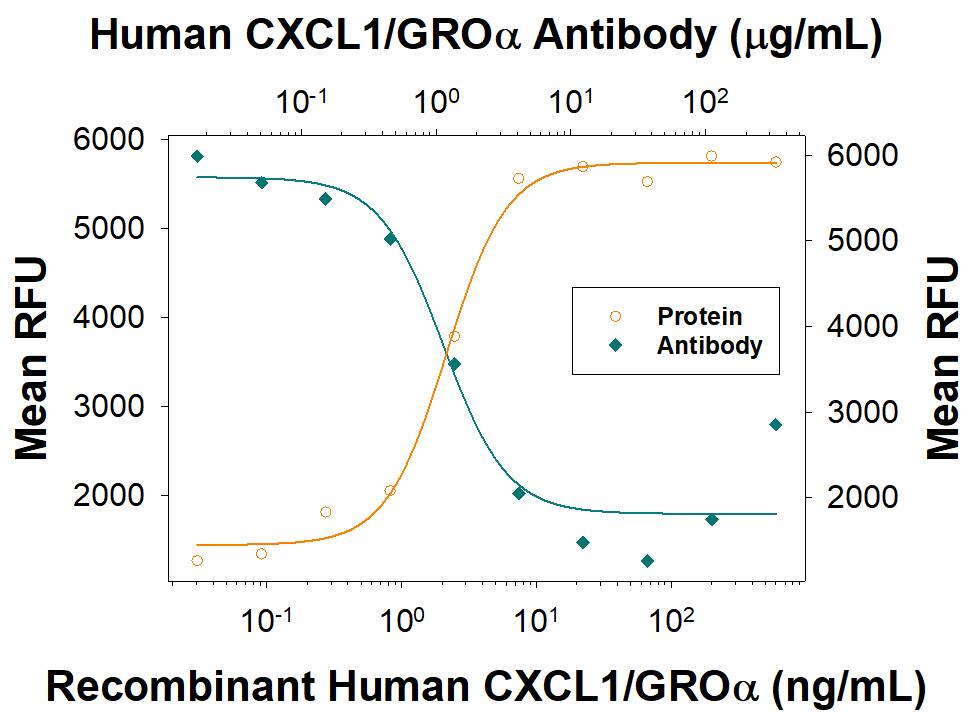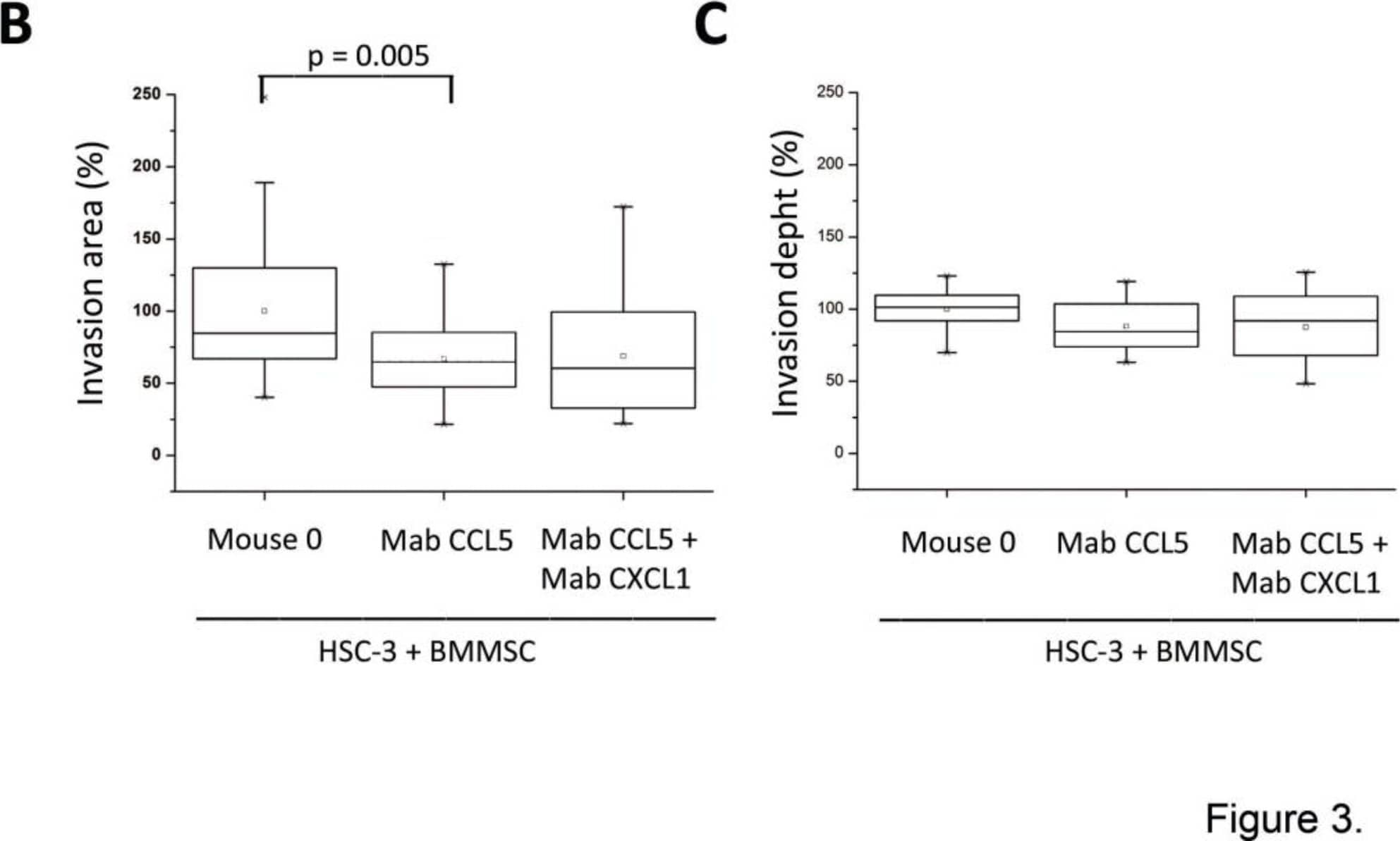Human/Primate CXCL1/GRO alpha/KC/CINC-1 Antibody
R&D Systems, part of Bio-Techne | Catalog # MAB275


Key Product Details
Validated by
Species Reactivity
Validated:
Cited:
Applications
Validated:
Cited:
Label
Antibody Source
Product Specifications
Immunogen
Specificity
Clonality
Host
Isotype
Endotoxin Level
Scientific Data Images for Human/Primate CXCL1/GRO alpha/KC/CINC-1 Antibody
Detection of CXCL1/GRO alpha/KC/CINC‑1 in Human PBMCs Treated with LPS and Monensin by Flow Cytometry.
Human peripheral blood mononuclear cell (PBMCs) treated with 1 µg/mL LPS for 24 hours and 3 µM monensin for 2 hours was stained with Mouse Anti-Human/Primate CXCL1/GROa/ KC/CINC-1 Monoclonal Antibody (Catalog # MAB275, filled histogram) or isotype control antibody (Catalog # MAB004, open histogram), followed by Phycoerythrin-conjugated Anti-Mouse IgG Secondary Antibody (Catalog # F0102B). To facilitate intracellular staining, cells were fixed with Flow Cytometry Fixation Buffer (Catalog # FC004) and permeabilized with Flow Cytometry Permeabilization/Wash Buffer I (Catalog # FC005).Chemotaxis Induced by CXCL1/GRO alpha and Neutralization by Human CXCL1/GRO alpha Antibody.
Recombinant Human CXCL1/GROa/KC/CINC-1 (Catalog # 275-GR) chemoattracts the BaF3 mouse pro-B cell line transfected with human CXCR2 in a dose-dependent manner (orange line). The amount of cells that migrated through to the lower chemotaxis chamber was measured by Resazurin (Catalog # AR002). Chemotaxis elicited by Recombinant Human/Primate CXCL1/GROa/KC/CINC-1 (10 ng/mL) is neutralized (green line) by increasing concentrations of Human CXCL1/GROa/KC/CINC-1 Monoclonal Antibody (Catalog # MAB275). The ND50 is typically 0.600 - 9.00 µg/mL.Detection of Human CXCL1/GRO alpha/KC/CINC-1 by Functional
The expression of chemokine CCL5 is up-regulated in co-cultures of BMMSCs cells and OTSCC.Co-culture of OTSCC cells with BMMSCs results in the high expression of chemokine CCL5 in HSC-3 and SAS cells, but not in dysplastic DOK cells (A). Function-blocking monoclonal antibody against CCL5 (Mab CCL5) slightly inhibits BMMSC enhanced invasion area, but has no effect on the invasion depth, whereas the antibody against CXCL1 does not increase the inhibitory effect in OTSCC invasion (B, C). Image collected and cropped by CiteAb from the following publication (https://pubmed.ncbi.nlm.nih.gov/24204919), licensed under a CC-BY license. Not internally tested by R&D Systems.Applications for Human/Primate CXCL1/GRO alpha/KC/CINC-1 Antibody
CyTOF-ready
Intracellular Staining by Flow Cytometry
Sample: Human peripheral blood mononuclear cell (PBMCs) treated with LPS and monensin were fixed with Flow Cytometry Fixation Buffer (Catalog # FC004) and permeabilized with Flow Cytometry Permeabilization/Wash Buffer I (Catalog # FC005)
Western Blot
Sample: Recombinant Human CXCL1/GRO alpha/KC/CINC-1 (Catalog # 275-GR)
Neutralization
Human/Primate CXCL1/GRO alpha Sandwich Immunoassay
Reviewed Applications
Read 1 review rated 5 using MAB275 in the following applications:
Formulation, Preparation, and Storage
Purification
Reconstitution
Formulation
Shipping
Stability & Storage
- 12 months from date of receipt, -20 to -70 °C as supplied.
- 1 month, 2 to 8 °C under sterile conditions after reconstitution.
- 6 months, -20 to -70 °C under sterile conditions after reconstitution.
Background: CXCL1/GRO alpha/KC/CINC-1
The gene for CXCL1/GRO alpha was initially discovered in hamster cells, using subtractive hybridization techniques, as a message that is over-expressed in tumorigenic cells and in normal cells during growth stimulation. The hamster cDNA was cloned and used as a probe for the subsequent cloning of the human GRO cDNA. Independently, a cDNA encoding a secreted protein with melanoma growth stimulating activity (MGSA) was also cloned from a human melanoma cell line and found to be identical to GRO. In addition to the initially cloned GRO gene, now designated CXCL1, two additional GRO genes, GRO beta or MIP-2 alpha and GRO gamma or MIP‑2 beta, which shared 90% and 86% amino acid sequence homology, respectively, with CXCL1, have been identified. All three human GROs are members of the alpha (C-X-C) subfamily of chemokines.
The three GRO cDNAs encode 107 amino acid precursor proteins from which the N-terminal 34 amino acid residues are cleaved to generate the mature GROs. There are no potential N-linked glycosylation sites in the amino acid sequences. GRO expression is inducible by serum or PDGF and/or by a variety of inflammatory mediators, such as IL-1 and TNF, in monocytes, fibroblasts, melanocytes, and epithelial cells. In certain tumor cell lines, GRO is expressed constitutively.
Similar to other alpha chemokines, the three GRO proteins are potent neutrophil attractants and activators. In addition, these chemokines are also active toward basophils. All three GROs can bind with high affinity to the IL-8 receptor type B. It remains to be seen if a unique GRO receptor(s) also exist. The rat homolog of human CXCL1, CINC, is much more active than human CXCL1 on rat neutrophils, suggesting that this cytokine may have selective species specificity.
Alternate Names
Gene Symbol
Additional CXCL1/GRO alpha/KC/CINC-1 Products
Product Documents for Human/Primate CXCL1/GRO alpha/KC/CINC-1 Antibody
Product Specific Notices for Human/Primate CXCL1/GRO alpha/KC/CINC-1 Antibody
For research use only

